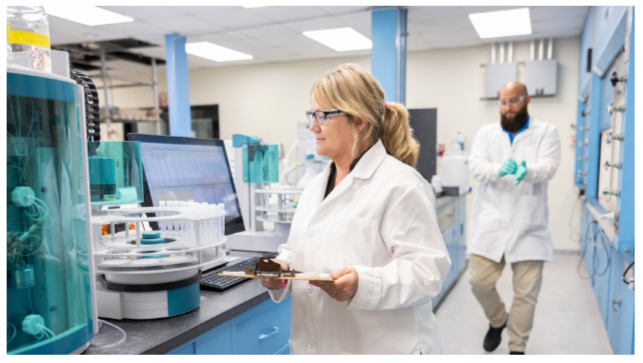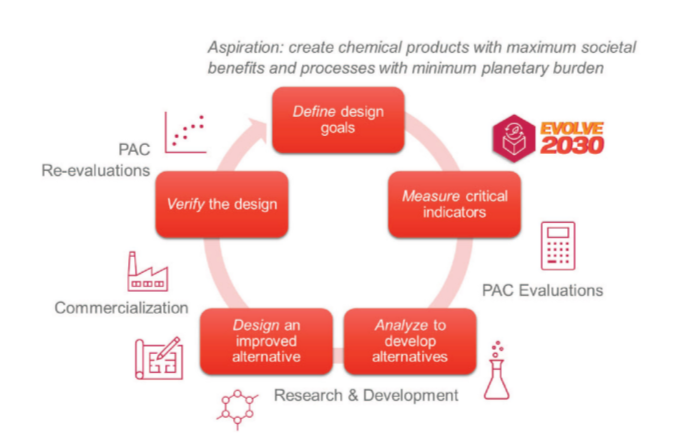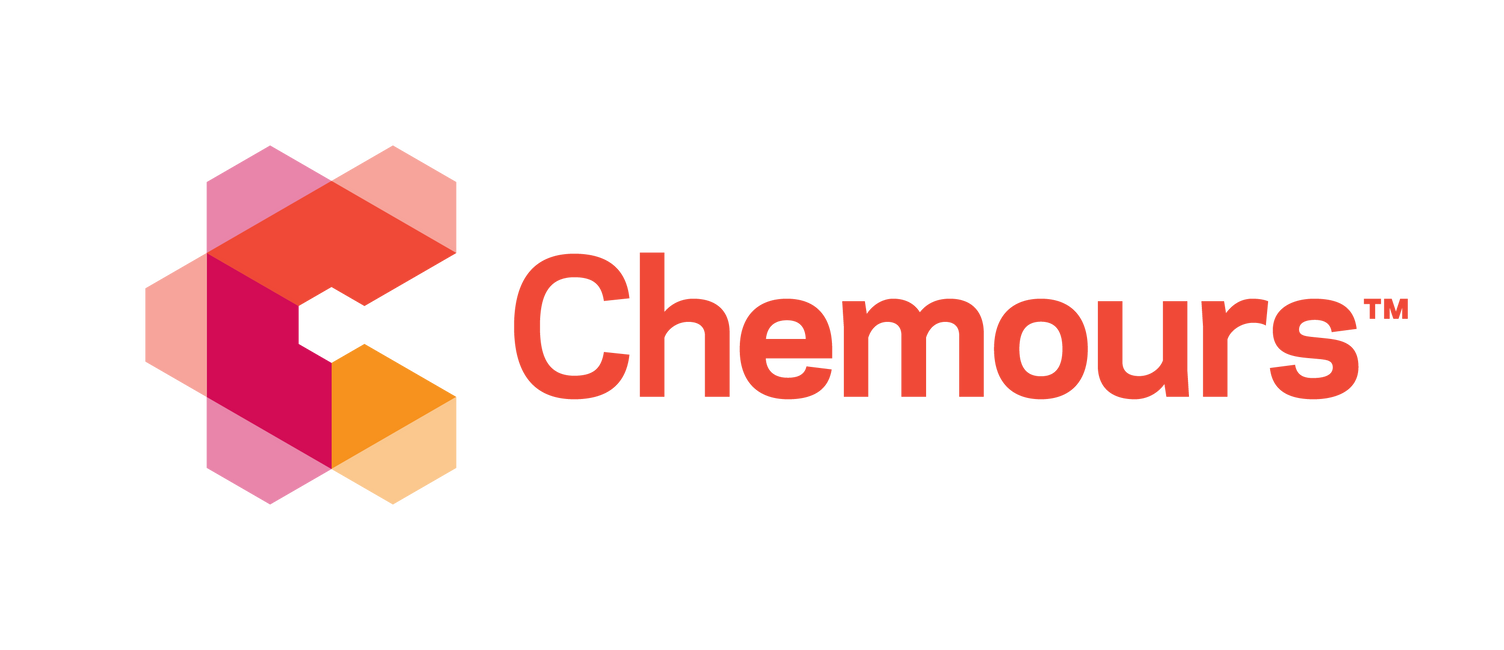Evolving EVOLVE 2030: Circularity as a New Evaluation Criterion
The circularity of products is playing an increasingly important role in the economy. The chemical company Chemours has also taken this into account in EVOLVE 2030 2.0: In the further developed methodology for the sustainability assessment of products, the circularity of materials and packaging is now a defined and central factor.
Chemours’ chemistry is essential for our everyday lives, be it in the refrigeration needed to preserve food and medicine, or in the critical components in our electronics and vehicles. This chemistry is also key to the emerging green technologies for artificial intelligence, clean hydrogen, and electric vehicles, which makes it all the more important to develop these chemistries responsibly and sustainably. The company has therefore set itself the target that, by 2030, 50 percent or more of its revenue will come from offerings that make a specific contribution to the UN Sustainable Development Goals (SDGs).
To achieve this goal, Chemours developed the EVOLVE 2030 methodology in 2019. The strategic approach evaluates the sustainability of Chemours products in relation to their specific use (Product Application Combination – PAC for short). The methodology used is based on the Portfolio Sustainability Assessment (PSA) of the World Business Council for Sustainable Development (WBCSD).
How does EVOLVE 2030 work?
In the first step, Chemours analyzes and evaluates the impact of the PAC on the environment and society (“imprint” of the PAC). To do this, the company analyzes various attributes such as the Greenhouse Gas (GHG) Emissions Intensity, and Human Health Risk. For each of these attributes, the PAC receives a score from minus two to plus two according to well-defined scoring rubrics. In the next step, the company evaluates the contribution of a PAC to the 169 SDG Targets (SDG contribution scoring). As making contributions to the UN SDGs is an important part of Chemours’ sustainability strategy, this dimension represents an essential signal category in EVOLVE 2030.
After assessing a PAC’s imprint and SDG contributions, it is assigned to one of four quadrants in a 2x2 matrix according to the outcome of the evaluation. This gives the company an overview of the sustainability performance of its product portfolio and identifies opportunities to further evaluate and improve. “Chemours is driven by our strong commitment to sustainability. Our EVOLVE 2030 methodology enhances our ability to align our business processes with this commitment, allowing us to better quantify the societal and environmental impacts of our products and guide our decisions accordingly,” says Dr. Amber Wellman, Chief Sustainability Officer at Chemours.
Evolving EVOLVE 2030
With the initial assessment of its portfolio nearly completed, 2024 was the perfect time for Chemours to improve the methodology and exemplify its culture of continuous improvement. Version 2 of EVOLVE 2030 incorporated experiences gained, including lessons from a study designed to find ways to increase reproducibility. “Reproducibility is critical to ensure the quality and integrity of our methodology. It gives us confidence that our results are accurate and trustworthy,” explains Kathy O’Keefe, Senior Director Product Sustainability.
In addition, Chemours had EVOLVE 2030 audited by an external global assurance provider. To provide full transparency, the auditor was given unrestricted access to the data systems where data, analyses, uncertainty scores, logic, conclusions, and evidence are stored, as well as the people involved. “We chose this approach to maximize the benefits of the effort and to learn from the auditor’s observations and comments,” says Kathy O’Keefe. The audit showed the strengths of the methodology and highlighted areas for improvement. Based on these experiences, Chemours further enhanced the methodology.
"Our EVOLVE 2030 methodology enhances our ability to align our business processes with sustainability."
Dr. Amber Wellman, Chief Sustainability Officer
Circularity as new attributes for evaluation
Two new and important evaluation criteria included in the methodology are the material circularity of products and product packaging. The first version of EVOLVE 2030 already considered circularity as part of the SDG contribution scoring, for example reducing resource consumption and waste generation are captured in SDG Targets 12.2 and 12.5 scores. In the further developed metho- dology, material circularity is much more specifically evaluated in new attributes for calculating the imprint of PACs, to increase its importance in the method. Chemours used various approaches to develop its working definition of circularity. These include the Ellen McArthur Foundation’s three principles of circular economy and butterfly diagram, the “reduce – reuse – recycle” approach of the US Environmental Protection Agency (EPA), and the nine “Rs” of the circular economy of the European Commission. Common to all three is the concept of a waste hierarchy that considers the environmental costs of those options. Using the US EPA’s phrase, solutions to “reduce” are usually better than those that enable “reuse” which are better than “recycle”. Based on these concepts, Chemours’ working definition is: “Circularity aims to minimize resources consumption and waste generation by keeping products and materials in use at their highest value for as long as possible.”
Calculation of product material circularity
Determining how circularity could be calculated and evaluated as an attribute of a PAC in the context of EVOLVE 2030 2.0 was not a simple or straightforward exercise. Chemours evaluated many ideas and approaches and found their answer in the WBCSD’s Circular Transition Indicators. This approach combines several parameters to create a single central indicator for calculating product material circularity. Both the inflow and outflow of a material are considered. The aim is to check how much circular inflow (e.g., renewable or recycled material) and how much circular outflow (potential and actual recovery) there is for a product. The outflow is calculated by multiplying the recovery potential by the actual recovery rate. To calculate the product material circularity of a PAC, the inflow and the previously calculated outflow are added together, and this value is then divided by two. All values are given as percentages.
Using this result as an indicator, the circularity of products – specifically the imprint of the PAC – can be evaluated in the next step. To do this, Chemours compares the calculated value with the Circularity Metric of the Circularity Gap Report – an independent and, above all, dynamic figure that is also cited by others, like WBCSD. Depending on whether the value of product material circularity is above or below that of the global economy (in 2023, this was 7.2 percent), the PAC receives a score between minus two and two for this attribute, depending on other considerations, such as the PAC’s impact on the entire system. “Looking too narrowly will likely lead to less than optimal and sometimes unintended outcomes,” says Andrew Liu, explaining the approach. Ultimately, the best option is to keep the value of a material in the cycle for as long as possible: “Recycling is not always the better option, as it often generates emission and waste and consumes resources, including energy; this is reflected in the waste hierarchies of many organizations.”
From theory to practice
A test phase followed in order to find out whether the equation and criteria produce realistic results and the method can be implemented. For example, the effects of upcycling and downcycling on the evaluation of a PAC were investigated. Chemours also used a sensitivity analysis to check how the methodology reacts to changes: do the output results respond appropriately and proportionally to different input data in a way that rewards investments to advance circularity while leaving enough room to entice further improvements?
Chemours made these initial test calculations by applying the methodology using hypothetical scenarios based on a range of relevant products and applications. Although these were not real figures, they were realistic and possible business cases. The company then moved on to a pilot project and tested the methodology with five real PACs from three different business units.
"We are proud to see the continued positive impact of EVOLVE 2030 on our existing portfolio and development pipeline."
Kathy O’Keefe, Senior Director Product Sustainability
Reassessment according to EVOLVE 2030 2.0
EVOLVE 2030 2.0 was rolled out in summer 2024, ahead of portfolio reevaluation using updated methodology and data. Because the quality of analyses depends on the quality of input data, a point of focus will be increasing data accuracy and reducing uncertainty. Data quality is therefore evaluated, tracked, and improvements prioritized. “In this way, we make progress with the best data available while understanding the reliability of our conclusions,” explains Ashley Pelura, PAC evaluations manager.
Gathering data for evaluating material circularity of PACs will present added challenges, especially those not directly controlled or accessible by Chemours. Help from colleagues in Procurement, Sales, Marketing, and Technical Service will be needed. If no direct evidence is available, data from market reports, reports from governments or Intergovernmental organizations, peer-reviewed journal articles, and other qualified sources will be used.
"We are proud to see the continued positive impact of EVOLVE 2030 on our existing portfolio and development pipeline. We are confident that embedding EVOLVE 2030 2.0 into our business and technology processes will not only help us achieve our 2030 Sustainability Goal but will inform decisions and transform our business to deliver a more resilient and sustainable portfolio for years to come,” says Kathy O’Keefe.
This article originally appeared in the 2024 Global Goals Yearbook.




